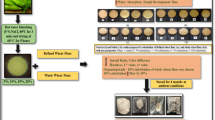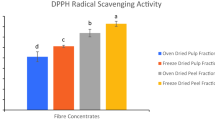Abstract
The effect of dietary fiber concentrate on the physicochemical, texture, and sensory characteristics in butter was studied by using some new fibers from vegetable and fruit waste. The basic aim of this study was to increase and develop the bio-functional properties of the butter by using fiber concentrates. For this reason new alternative dietary fiber concentrate sources were investigated and developed by using vegetable and fruit wastes such as stone pears, celery root, celery leaves, spinach, oranges, and orange albedo. Dry matter, ash, pH, protein, dietary fiber content, glucose retardation index, color analysis, and water- and oil-holding capacities as technological properties of samples were analyzed. Dry matter, ash, and pH values of dietary fiber concentrates were observed in the range of 5.79–8.87 %, 0.45–0.96 %, and 3.90–6.48, respectively. As technological properties of samples, water- and oil-holding capacities and fiber contents of dietary fiber concentrates were changed 2.3–8.4 mL/g, 1.8–6.4 mL/g, and 65.45–87.32 %, respectively. On the other hand, it was seen that all dietary fiber concentrates reduced glucose in dialysate when compared to control. Different concentrations (3 and 5 %) of dietary fiber concentrates were added to butter to increase its bio-functional properties. Color and textural properties of the butters were determined. The results showed that content and type of the dietary fiber concentrate in the butter model changed the hardness and the spreadability rating as textural properties and the same effects also were observed in color parameters and sensory evaluation. According to the simple additive weighting technique, stone pear dietary fiber concentrate (3 %) and orange albedo dietary fiber concentrate (5 %) samples were mostly preferred in each group. When the two groups were compared, simple additive weighting technique results showed that butter produced with stone pear dietary fiber concentrate (3 %) was the most preferred by panelists.





Similar content being viewed by others
References
Hipsley EA (1953) Dietary fibre and pregnancy toxaemia. Br Med J 2:420–422
Al-Sheraji SH, Ismail A, Manap MY, Mustafa S, Yusof RM, Hassan FA (2013) Prebiotics as functional foods: a review. J Funct Foods 5:1542–1553
Rodrıguez R, Jimenez A, Fernandez-Bolanos J, Guillen R, Heredia A (2006) Dietary fibre from vegetable products as source of functional ingredients. Trends Food Sci Technol 17:3–15
Brennan SC (2005) Dietary fibre, glycaemic response, and diabetes. Mol Nutr Food Res 49:560–570
Alissa EM, Ferns GA (2015) Dietary fruits and vegetables and cardiovascular diseases risk. Crit Rev Food Sci Nutr. doi:10.1080/10408398.2015.1040487
Liese AD, Roach AK, Sparks KC, Marquart L, D’Agostino RB Jr, Mayer-Davis EJ (2003) Whole-grain intake and insulin sensitivity: the Insulin Resistance Atherosclerosis Study. Am J Clin Nutr 78:965–971
Thril U, Fernández-López J, Pérez Álvarez JA, Viuda-Martos M (2014) Chemical, physicochemical, technological, antibacterial and antioxidant properties of rich-fibre powder extract obtained from tamarind (Tamarindus indica L.). Ind Crop Prod 55:155–162
Martínez R, Torres P, Meneses MA, Figueroa JG, Pérez Álvarez JA, Viuda-Martos M (2012) Chemical, technological and in vitro antioxidant properties of mango, guava, pineapple and passion fruit dietary fibre concentrate. Food Chem 135:1520–1526
Wong KH, Cheung PCC (2009) Enzymatic preparation of mushroom dietary fibre: a comparison between analytical and industrial enzymes. Food Chem 115:795–800
Nilnakara S, Chiewchan N, Devahastin S (2009) Production of antioxidant dietary fibre powder from cabbage outer leaves. Food Bioprod Process 87:301–307
Abe LT, Lajolo FM, Genovese MI (2012) Potential dietary sources of ellagic acid and other antioxidants among fruits consumed in Brazil: jabuticaba (Myrciaria jaboticaba (Vell.) Berg). J Sci Food Agric 92:1679–1687
Gurmeric V, Doğan M, Toker ÖS, Senyiğit E, Ersoz NB (2013) Application of different multi-criteria decision techniques to determine optimum flavour of prebiotic pudding based on sensory analyses. Food Bioprocess Technol 6:2844–2859
Vincke P (1992) Multicriteria decision-aid. Wiley, New York
Pohekar SD, Ramachandran M (2004) Application of multi-criteria decision making to sustainable energy planning—a review. Renew Sustain Energy Rev 8:365–381
Ozturk G, Dogan M, Toker OS (2014) Physicochemical, functional and sensory properties of mellorine enriched with different vegetable juices and TOPSIS approach to determine optimum juice concentration. Food Biosci 7:45–55
AOAC (2000) In official methods of analysis of AOAC International, 17th edn. 1(4). Association of Official Analytical Chemists, Washington
Lario Y, Sendra E, Garcıa-Perez J, Fuentes C, Sayas-Barbera E, Fernandez-Lopez J, Perez-Álvarez JA (2004) Preparation of high dietary fiber powder from lemon juice by-products. Innov Food Sci Emerg 5:113–117
Jiménez-Escrig A, Sánchez-Muniz FJ (2000) Dietary fibre from edible seaweeds: chemical structure, physicochemical properties and effects on cholesterol metabolism. Nutr Res 20:585–598
Jenkins DAJ, Jenkins MJA, Wolever TMS, Taylor RH, Ghafari H (1986) Slow release carbohydrate: mechanism of action of viscous fibres. J Clin Nutrition Gastroenterol 1:237–240
Bravo L (1999) Propiedades y aplicaciones de la fibra de algarroba (Prosopis pallida L.). Alimentaria 13:67–73
Hassan FA, Ismail A, Hamid AA, Azlan A, Al-sheraji SA (2011) Characterisation of fibre-rich powder and antioxidant capacity of Mangifera pajang K. fruit peels. Food Chem 126:283–288
Saaty TL (1980) The analytic hierarchy process. McGraw-Hill, New York
Fernandez-Ginees JM, Fernandez-Loopez J, Sayas-Barber E, Sendra E, Perez-Alvarez JA (2004) Lemon albedo as a new source of dietary fiber: application to bologna sausages. Meat Sci 67:7–13
Larrigaudière C, Lentheric I, Puy J, Pintó E (2004) Biochemical characterisation of core browning and brown heart disorders in pear by multivariate analysis. Postharvest Biol Technol 31:29–39
Acknowledgments
This study was supported by Erciyes University Scientific Research Unit as master thesis (Project Code: FBY-09-1091).
Author information
Authors and Affiliations
Corresponding author
Ethics declarations
Conflict of interest
None.
Compliance with ethics requirements
This article does not contain any studies with human or animal subjects.
Rights and permissions
About this article
Cite this article
Göksel Saraç, M., Dogan, M. Incorporation of dietary fiber concentrates from fruit and vegetable wastes in butter: effects on physicochemical, textural, and sensory properties. Eur Food Res Technol 242, 1331–1342 (2016). https://doi.org/10.1007/s00217-016-2637-9
Received:
Revised:
Accepted:
Published:
Issue Date:
DOI: https://doi.org/10.1007/s00217-016-2637-9




